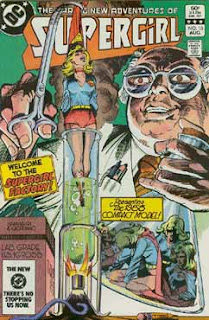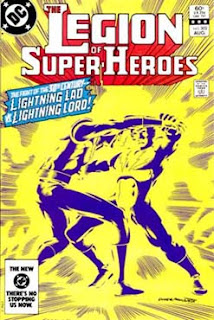Wednesday, May 22, 2024
Wednesday Comics: DC, August 1983 (week 3)
Monday, May 20, 2024
Clerics and Druids
Thursday, May 16, 2024
Roaming the Mind of Gob
After a hiatus we returned to the Land of Azurth last Tuesday and picked up where we left off in an adaptation of the Role-Aids adventure Swordthrust. The party was roaming the labyrinth inside the mind (or at least brain) of the giant, crystalline gnome, Gob. They were trying to collect all the pieces of a magical suit of armor.
This time, they avoided some fights with some Rat folk cultists, a dining troll, and a kobold Necromancer:
This, and their previous expressions of solidarity with some goblin revolutionaries made their job of exploring the dungeon easier because it allowed them to backtrack through controlled territory. This was particularly useful then they wanted to move from one "hemisphere" of Gob's brain to the other.
They didn't negotiate their way around everything, though. They had to kill an irate cockatrice and 3 disagreeable harpies:
 |
| Like these guys but more birdy |
No armor pieces discovered this session, so the quest continues!
Wednesday, May 15, 2024
Wednesday Comics: DC, August 1983 (week 2)
Monday, May 13, 2024
The Kingdom of the Planet of the Apes
Despite the attention lavished on the Marvel Cinematic Universe, Star Wars, and even Star Trek or the Alien universe, I feel like the science fiction franchise most consistent in quality is the Planet of the Apes. Sure, it's not without its duds (Burton's film) and lesser lights (the last original film, the cartoon, perhaps), but the Wyatt/Reeves reboot?/prequel? series of the 2010s defied sequel gravity and only got better as it went along. (To me, anyway. Some would say Dawn was the high point. Either way, War was still good.)
Thursday, May 9, 2024
Notes on the Common Kin
Wednesday, May 8, 2024
Wednesday Comics: DC, August 1983 (week 1)
Monday, May 6, 2024
The Age of the Wizard-Kings
One wily titan, eager for revenge against the traitorous gods, gave mortals the secret of the paths of Immortality--a means to make themselves near equal to the gods. When the gods shut the gates of the Overworld, barring mortals from Heaven, their former champions began seeking their own apotheosis. What wouldn't be shared, they reasoned, they would take.
Connecting with the pillars that supported the cosmos--the so-called Spheres of Matter, Energy, Thought, and Time--mortals began to walk the paths to Immortality. In the process, they discovered more secrets of the Cosmos's creators. They developed technology that allowed them to conquer the world and usher in an age of advancement and wonder with flying cities, automata, and sagacious, living libraries. It was also an age of excess and violence with strange monsters crawling from the subterranean laboratories and towering war machines wielding eldritch weapons to lay waste to cities. This time was known as the Age of High Magic or the Age of the Wizard-Kings.
The end of the Age came when internecine fighting had weakened the Wizard-Kings such that they could not defend against a succession of threats: the forces of Chaos launching sorties into the Cosmos, and irruptions of the Underworld caused by the Lich Lords, and continued subversion by the fiends from Hell. In the end, a coup by chromatic dragons toppled the most powerful surviving Wizard-Kings.
The remnants of their power remain, though. In the ruins of sky cities or in the depths of the dungeons they built adventurers still encounter they creations, technology and servitors. Perhaps somewhere the secrets of Immortality await the lucky delver?
Thursday, May 2, 2024
The Undying Kings of the Underworld
In the aftermath of the Titan War, with the withdrawal of the gods left from the world, humans were able to seize divine knowledge and tools as spoils of war. This theft would reverberate even far, even to the gloomy halls of the Underworld.
There were the recently arrived souls of great mages and heroes, fallen in the war either fighting for the titans or the gods. These personalities burning with power and rage at the perceived injustice of the universe, resisted the pull of dissolution. Their souls would not enter the cycle of reincarnation. Without the Unseen Lord, God of the Underworld, to quell their rebellion, they ransacked the cities and forests of the lands of the dead to find a way out. Their frenzy cracked the Underworld itself, and they found themselves on the event horizon of the Negative Energy Plane.
They stared into the abyss and the abyss stared back. And then, perhaps, something within it spoke. The great mages and heroes discovered a way for their intellects to live beyond death, and even to be returned to their physical bodies. To power these miracles, they would need to build receptacles to house the negative energy. The only accommodation necessary to utilize this new and seemingly endless replacement for their life force was a small one. They would just have to give up their souls.
These nine (so it is believed) Undying Kings, or Lich Lords as they are sometimes called, became the new rulers of the Underworld. When that was accomplished, they sought to extend their reach to the world of the living. They sent tendrils of Underworld rising up, and the swirling mists formed cysts of the land of the dead, the Shadowfells. From these bridgeheads, the lich lords raised armies of undead, led by mighty warriors, called Death Knights.
Their conquest of the world of the living isn't driven merely by a desire for territory. Their goad is the Negative Energy Plane, and its hunger for unmaking and entropy. Their own fates are tied to its eternal appetite, so it's needs are their necessity. The self-centered nature of the Lich Lords has hampered their cooperation, and that combined with the weakening of the Shadowfells in daylight hours has slowed their advancement, but the Undying Kings are not hurried as time is something they have in abundance.
This is part of this setting.
Wednesday, May 1, 2024
Wednesday Comics: DC, July 1983 (week 4)
Monday, April 29, 2024
Larry MacDougall's Gwelf
Gwelf: The Survival Guide (2021) is a gorgeous art book by Larry MacDougall who once upon a time did art for Palladium and Magic: The Gathering. I say it's an art book, because that's what Amazon likely calls it, but in the rpg world it could credibly be called a systemless setting book.
Gwelf is a Medieval(ish) land of anthropomorphic animals. Its author says it's like a cross between Wind in the Willows and Lord of the Rings and that's not just high concept, but pretty much literally the case. Gwelf is the last bit of civilization of the border. It's a place where Otters, Foxes, Badgers, and the sage Sparrows come together peacefully, but beyond the frontier are the Hinterlands where the Ravenfolk hold sway. They're practitioners of dark magic.
This book details the peoples and cultures of Gwelf. There's another book on the way in June, which promises to reveal more about the Hinterlands.









































.jpg)


















